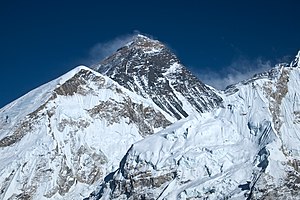
Mount Everest is Earth's highest mountain above sea level, located in the Mahalangur Himal sub-range of the Himalayas. The China–Nepal border runs across its summit point. Its elevation of 8,848.86 m was most recently established in 2020 by the Chinese and Nepali authorities.

Lhotse is the fourth-highest mountain on Earth, after Mount Everest, K2, and Kangchenjunga. At an elevation of 8,516 metres (27,940 ft) above sea level, the main summit is on the border between Tibet Autonomous Region of China and the Khumbu region of Nepal.

The North Col refers to the sharp-edged pass carved by glaciers in the ridge connecting Mount Everest and Changtse in Tibet. It forms the head of the East Rongbuk Glacier.
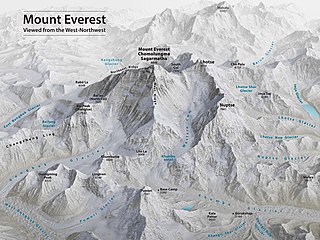
Mount Everest is the world's highest mountain, with a peak at 8,849 metres (29,031.7 ft) above sea level. It is situated in the Himalayan range of Solukhumbu district, Nepal.

The 1996 Mount Everest disaster occurred on 10–11 May 1996 when eight climbers caught in a blizzard died on Mount Everest while attempting to descend from the summit. Over the entire season, 12 people died trying to reach the summit, making it the deadliest season on Mount Everest at the time and the third deadliest after the 23 fatalities resulting from avalanches caused by the April 2015 Nepal earthquake and the 16 fatalities of the 2014 Mount Everest avalanche. The 1996 disaster received widespread publicity and raised questions about the commercialization of Everest.
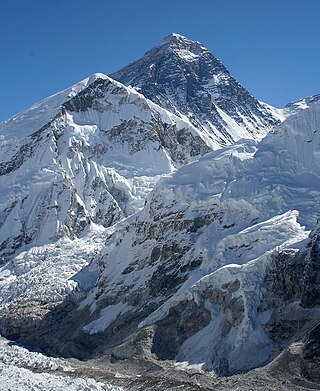
The 2006 Philippine Mount Everest expedition is a Filipino mountaineering expedition that made a successful attempt to reach the summit of Mount Everest via the traditional southeast ridge route in May 2006 during the spring climbing season in the Himalayas. It was the first national expedition organized by the Philippines to reach the summit of world's highest mountain.

Cuthbert Wilfrid Francis Noyce was an English mountaineer and author. He was a member of the 1953 British Expedition that made the first ascent of Mount Everest.

The 1924 British Mount Everest expedition was—after the 1922 British Mount Everest expedition—the 2nd expedition with the goal of achieving the first ascent of Mount Everest. After two summit attempts in which Edward Norton set a world altitude record of 8,572.8 metres (28,126 ft), the mountaineers George Mallory and Andrew "Sandy" Irvine disappeared on the third attempt. Their disappearance has given rise to the long-standing speculation of whether or not the pair might – under a narrow set of assumptions – have reached the summit. Mallory's body was found in 1999 at 8,156 metres (26,760 ft), but the resulting clues did not provide any conclusive evidence as to whether the summit was reached.

The 1922 British Mount Everest expedition was the first mountaineering expedition with the express aim of making the first ascent of Mount Everest. This was also the first expedition that attempted to climb Everest using bottled oxygen. The expedition attempted to climb Everest from the northern side out of Tibet. At the time, Everest could not be attempted from the south out of Nepal as the country was closed to Western foreigners.
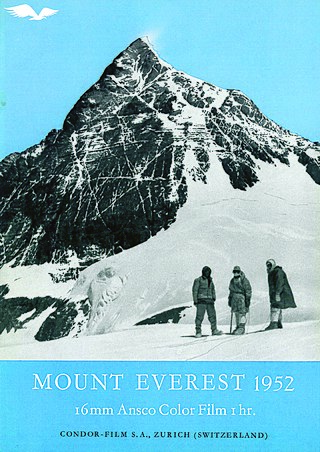
The 1952 Swiss Mount Everest expedition was an attempt to summit Mount Everest. Led by, Edouard Wyss-Dunant, the expedition, which included Tenzing Norgay, reached a height of 8,595 metres (28,199 ft) on the southeast ridge, setting a new climbing altitude record and opening up a new route to Mount Everest and paving the way for further successes by other expeditions. Norgay successfully summited the mountain the following year with Sir Edmund Hillary, the first successful expedition.

The 1953 British Mount Everest expedition was the ninth mountaineering expedition to attempt the first ascent of Mount Everest, and the first confirmed to have succeeded when Tenzing Norgay and Edmund Hillary reached the summit on 29 May 1953. Led by Colonel John Hunt, it was organised and financed by the Joint Himalayan Committee. News of the expedition's success reached London in time to be released on the morning of Queen Elizabeth II's coronation, on 2 June that year.
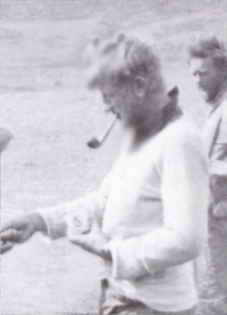
Leslie Vickery Bryant, known as Dan Bryant, was a New Zealand school teacher and a mountain climber. He was a member of the 1935 British Mount Everest reconnaissance expedition, which was a preliminary to the full expedition of 1936 that attempted the summit. However in 1935 Bryant did not acclimatise well to altitude above 23,000 feet (7,000 m), and so was not included in the party for 1936. He was a very accomplished ice climber, and was well-liked on expeditions. These two factors led, indirectly, to his compatriot Edmund Hillary becoming a member of the successful 1953 British Mount Everest expedition.
The 1936 British Mount Everest expedition was a complete failure, and raised questions concerning the planning of such expeditions. This was Hugh Ruttledge's second expedition as leader. Heavy snows and an early monsoon forced their retreat on several occasions, and on the final attempt two climbers narrowly survived an avalanche. This was the first expedition in which climbers were able to carry portable radios.

Led by Bill Tilman, the 1938 British Mount Everest expedition was a low-key, low-cost expedition which was unlucky in encountering a very early monsoon. The weather conditions defeated the attempts to reach the summit. The North Col was climbed for the first time from the west and an altitude of 27,200 feet (8,300 m) was reached on the North Ridge.

The Mount Everest climbing season of 2017 began in spring with the first climbers reaching the top on May 11, from the north side. The first team on the south side reached the top on May 15. By early June, reports from Nepal indicated that 445 people had made it to the summit from the Nepali side. Reports indicate 160–200 summits on the north side, with 600–660 summiters overall for early 2017. This year had a roughly 50% success rate on that side for visiting climbers, which was down from other years. By 2018, the figure for the number of summiters of Everest was refined to 648. This includes 449 which summited via Nepal and 120 from Chinese Tibet.

Kami Rita, Thame, Solukhumbu District, Nepal is a Nepali Sherpa guide who, since May 2018, has held the record for most ascents to the summit of Mount Everest. Most recently, he scaled the mountain for a 29th time on 12 May 2024, breaking his own record set on 23 May 2023. His father was among the first professional Sherpa guides after Everest was opened to foreign mountaineers in 1950. His brother Lakpa Rita, also a guide, scaled Everest 17 times.

Mount Everest in 2016 covers events about Mount Everest, the highest mountain on Earth located in Nepal and Chinese Tibet in Asia. It is a popular climbing destination for extreme high altitude climbers, with several hundred climbing each year despite various dangers.

Mount Everest in 2018 is about events in the year about the highest Earth mountain, Mount Everest, a popular mountaineering tourism and science destination in the 2010s. In 2018, 807 climbers summited Mount Everest, which is a popular mountaineering goal. This year is noted for an especially long weather window of 11 days straight of calm, which reduced crowding at the high base camps. With over 800 reaching the top, it was the highest amount ever to reach the top in recorded history, besting the previous year by over 150 summitings.

The 1955 British Kangchenjunga expedition succeeded in climbing the 28,168-foot (8,586 m) Kangchenjunga, the third highest mountain in the world, for the first time. The expedition complied with a request from the Sikkim authorities that the summit should not be trodden on so the climbers deliberately stopped about five feet below the summit. George Band and Joe Brown reached the top on 25 May 1955, and they were followed the next day by Norman Hardie and Tony Streather. The expedition was led by Charles Evans who had been deputy leader on the 1953 British Mount Everest expedition.

